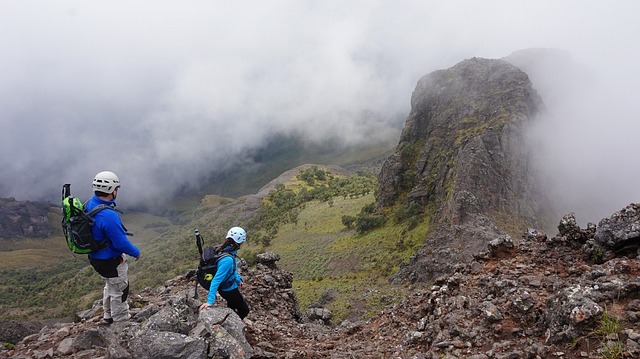Are you ready to take on the challenge of high-altitude hiking? Imagine standing at the summit of a majestic mountain, surrounded by breathtaking vistas and a sense of accomplishment. But before you lace up your boots and hit the trails, it’s important to prepare yourself physically and mentally for the demands of hiking at high altitudes.
In this guide, I’ll share with you everything you need to know about training for high-altitude hiking. I’ve had my fair share of experiences hiking at high altitudes, and I understand the challenges that come with it. That’s why I’m thrilled to share my knowledge and insights with you. From understanding the effects of altitude on your body to developing a comprehensive training plan, I’ll cover it all. So, let’s embark on this exciting journey together and get ready to conquer those lofty peaks!
Understanding High Altitude Hiking:
Before I dive into the nitty-gritty of training, it’s important to understand what high-altitude hiking entails. So, let’s take a moment to grasp the concept and its effects on our bodies.
High altitude refers to elevations above 8,000 feet (2,400 meters) where the air becomes thinner, and the oxygen levels decrease. As you ascend to higher altitudes, the atmospheric pressure decreases, making it more challenging for your body to take in the necessary oxygen it needs to function optimally.
One of the most common challenges hikers face at high altitudes is altitude sickness, also known as acute mountain sickness (AMS). It can cause symptoms like headache, nausea, dizziness, fatigue, and shortness of breath. It’s important to note that altitude sickness can affect anyone, regardless of their fitness level or prior experience. However, the severity of symptoms can vary from person to person.
Acclimatization, the process of gradually adjusting to higher altitudes, is crucial to minimize the risk of altitude sickness. Your body needs time to adapt to the reduced oxygen levels, and rushing the ascent can increase the chances of experiencing symptoms.
Now that you have a better understanding of high-altitude hiking and its effects, let’s move on to the next step: assessing your current fitness level and identifying areas where you can improve to prepare for the adventure ahead.
Assessing Your Fitness Level:
Assessing your current fitness level is a crucial step in preparing for high-altitude hiking. It allows you to understand your strengths and weaknesses, and identify areas where you can focus your training efforts. So, let’s take a moment to evaluate where you stand.
Cardiovascular Endurance
High-altitude hiking requires a good level of cardiovascular endurance, as it involves prolonged periods of exertion at reduced oxygen levels. To assess your cardiovascular fitness, consider the following:
- Can you comfortably engage in aerobic activities like jogging, cycling, or swimming for at least 30 minutes without feeling overly fatigued?
- How quickly does your heart rate return to normal after vigorous exercise?
- Do you experience shortness of breath during physical activities?
Strength
Having adequate strength is vital for carrying your backpack, navigating uneven terrain, and maintaining balance on steep slopes. Evaluate your strength level by considering the following:
- Can you perform exercises like squats, lunges, planks, push-ups, and pull-ups with proper form and without excessive strain?
- Are your leg muscles, core, and upper body strong enough to endure the demands of hiking?
- Do you experience muscle fatigue or weakness during activities that require strength?
Flexibility and Balance
Flexibility and balance play key roles in preventing injuries and maintaining stability while hiking. Reflect on the following:
- Can you comfortably touch your toes and perform basic stretching exercises?
- Do you have good balance and stability when standing on one leg or navigating rocky terrain?
- Do you experience muscle tightness or stiffness after physical activity?
By honestly assessing your fitness level in these areas, you’ll gain valuable insights into where you need to focus your training efforts. Don’t worry if you discover areas for improvement; that’s precisely why you’re here—to train and get better together! In the next section, I’ll dive into creating a comprehensive training plan to enhance your performance for high-altitude hiking.
Training Plan:
Now that you have assessed your fitness level and identified areas for improvement, it’s time to create a training plan tailored specifically for high-altitude hiking. This plan will help you build the necessary endurance, strength, flexibility, and balance required for a successful and enjoyable hiking experience. Let’s break it down into three key components: cardiovascular endurance, strength training, and flexibility/balance exercises.
Cardiovascular Endurance
Improving your cardiovascular endurance will enhance your stamina and ability to sustain physical activity for extended periods at high altitudes. Here are some training strategies to consider:
- Aerobic Exercises: Engage in activities that elevate your heart rate and increase your breathing. Some excellent options include:
- Running or jogging
- Cycling
- Swimming
- Hiking at lower altitudes
- Interval Training: Incorporate intervals of higher intensity into your workouts to challenge your cardiovascular system and mimic the demands of high-altitude hiking. For example, alternate between periods of fast running or cycling with slower recovery periods.
- Gradual Progression: Start with shorter durations and lower intensity levels, gradually increasing both duration and intensity over time. This allows your body to adapt and build endurance without overexertion.
Strength Training
Building strength in your leg muscles, core, and upper body is crucial for carrying your backpack, navigating challenging terrain, and maintaining stability. Consider the following training strategies:
- Bodyweight Exercises: Incorporate exercises that target multiple muscle groups and require no equipment, such as:
- Squats and lunges
- Planks and mountain climbers
- Push-ups and tricep dips
- Resistance Training: Utilize resistance bands or weights to add challenge and increase muscle strength. Include exercises like:
- Deadlifts and step-ups
- Shoulder presses and bicep curls
- Bent-over rows and chest presses
- Functional Exercises: Mimic the movements and challenges you’ll encounter while hiking, such as:
- Walking lunges with a backpack
- Stair climbing or step-ups
- Single-leg squats for balance and stability
Flexibility and Balance
Improving flexibility and balance will enhance your overall performance and reduce the risk of injuries. Incorporate the following exercises into your training routine:
- Stretching: Prioritize dynamic stretching before your workouts and static stretching after. Focus on stretching your leg muscles, hips, lower back, and shoulders.
- Yoga or Pilates: Engage in yoga or Pilates sessions to improve flexibility, core strength, and balance. These practices also help with breathing control and mental focus.
- Balance Exercises: Perform exercises that challenge your balance and stability, such as:
- Single-leg stands
- Bosu ball exercises
- Yoga poses like Tree Pose or Warrior III
Remember to listen to your body and gradually increase the intensity and duration of your training sessions. Allow for proper rest and recovery between workouts to avoid overtraining and reduce the risk of injuries.
Next, I’ll discuss altitude-specific training techniques to simulate high-altitude conditions. Stay tuned, and keep up the great work with your training!
Altitude-specific Training:
As you prepare for high-altitude hiking, it’s beneficial to incorporate altitude-specific training techniques into your routine. These methods help simulate the challenges of high altitude conditions, allowing your body to adapt and improve its performance. Let’s explore some altitude-specific training strategies:
- Simulate High Altitude Conditions: While it may not be feasible for everyone to train at high altitudes, you can still replicate the conditions to some extent. Here’s how:
- Increase the intensity of your workouts: Push yourself a little harder during cardio and strength training exercises to simulate the increased effort required at higher altitudes.
- Use incline settings: Set your treadmill or stationary bike to a higher incline to mimic the uphill climbs you’ll encounter during high-altitude hikes.
- Find hilly or mountainous areas: Seek out hilly terrains or trails with elevation gains to practice hiking uphill and downhill, building your endurance and leg strength.
- Altitude Training Masks: Altitude training masks restrict airflow, simulating the reduced oxygen levels at higher altitudes. By using these masks during workouts, you can challenge your respiratory system and improve your ability to take in oxygen efficiently. Start with lower resistance levels and gradually increase as you adapt.
- Hypoxic Training: Hypoxic training involves exposing yourself to low-oxygen environments, usually through specialized equipment or facilities. This technique can help stimulate physiological adaptations, but it’s important to consult with a professional before attempting hypoxic training methods.
- Gradual Ascent: If you have the opportunity to train in locations at higher altitudes, consider gradually ascending to give your body time to acclimatize. Begin at lower altitudes and progressively increase the elevation over time. This approach allows your body to adapt more effectively, reducing the risk of altitude sickness.
Remember, altitude-specific training techniques are supplemental to your overall training plan. They help you prepare for the unique challenges of high-altitude hiking, but they shouldn’t replace the foundation of cardiovascular endurance, strength training, and flexibility exercises I discussed earlier.
Next, I’ll shift my focus to nutrition and hydration, exploring how to fuel your body properly for high-altitude hikes.
Nutrition and Hydration:
Proper nutrition and hydration play a crucial role in optimizing your performance and overall well-being during high-altitude hiking. Fueling your body with the right nutrients and staying hydrated will help maintain energy levels, support muscle function, and mitigate the effects of altitude. Let’s delve into some key nutrition and hydration strategies:
Balanced Diet
Maintain a balanced diet that includes a variety of nutrient-rich foods. Focus on the following components:
- Carbohydrates: These are your body’s primary source of energy. Prioritize complex carbohydrates like whole grains, fruits, vegetables, and legumes. They provide sustained energy and help replenish glycogen stores.
- Protein: Adequate protein intake is essential for muscle repair and recovery. Include lean sources of protein such as poultry, fish, beans, nuts, and dairy products.
- Healthy Fats: Incorporate sources of healthy fats like avocados, nuts, seeds, and olive oil. These provide essential fatty acids and help with nutrient absorption.
Pre-Hike Nutrition: Fuel your body before hitting the trails with a well-balanced meal or snack rich in carbohydrates, moderate in protein, and low in fat. Aim to consume this meal or snack 1-2 hours before your hike to allow for digestion. Some options include oatmeal with fruits and nuts, a whole-grain sandwich with lean protein, or a smoothie with fruits and yogurt.
Hydration:
Staying properly hydrated is crucial at high altitudes, as dehydration can exacerbate the symptoms of altitude sickness. Here are some hydration tips:
- Drink water consistently throughout the day, aiming for at least 8-10 cups. Increase your intake if you’re sweating more due to exertion or warmer temperatures.
- Carry a water bottle or hydration bladder during hikes and drink regularly, even if you don’t feel excessively thirsty.
- Consider using electrolyte solutions or sports drinks to replenish lost electrolytes during longer hikes. These can help maintain hydration and prevent muscle cramps.
- Avoid Alcohol and Caffeine: Limit your consumption of alcohol and caffeine, as they can contribute to dehydration and exacerbate the effects of altitude. If you do consume these beverages, do so in moderation and ensure you’re compensating with additional water intake.
- Snack Smartly: Pack lightweight, nutritious snacks to sustain your energy levels during hikes. Opt for options like trail mix, energy bars, dried fruits, nuts, and granola. These provide a good balance of carbohydrates, protein, and healthy fats.
Remember, everyone’s nutritional needs may vary, so listen to your body and make adjustments accordingly.
In the next section, I’ll discuss the importance of mental preparation and share tips to keep your mind focused and resilient during challenging hikes.
Mental Preparation:
While physical training is essential, it’s equally important to prepare yourself mentally for the challenges of high-altitude hiking. A positive mindset and mental resilience can make a significant difference in your overall experience. Here are 7 tips to help you mentally prepare:
- Set Realistic Goals and Expectations: Establish realistic goals for your high altitude hike, considering factors such as distance, elevation gain, and your current fitness level. Setting achievable goals helps maintain motivation and prevents unnecessary disappointment. Remember, each hike is a unique experience, and it’s okay to adjust your goals based on the conditions and how you feel.
- Visualize Success: Take some time to visualize yourself successfully completing your high-altitude hike. Imagine the breathtaking views, the sense of accomplishment, and the joy of being surrounded by nature. Visualizing positive outcomes can boost confidence and motivation.
- Develop a Positive Mindset: Maintaining a positive mindset is crucial, especially when faced with challenges. Instead of dwelling on difficulties, focus on the beauty of the surroundings, the progress you’re making, and the resilience within you. Embrace the journey and trust in your abilities.
- Practice Deep Breathing and Meditation: Deep breathing exercises and meditation techniques can help calm your mind, reduce stress, and enhance focus. Take a few moments each day to practice deep, slow breaths, and incorporate mindfulness or meditation into your routine. These practices can be particularly beneficial during moments of altitude-related discomfort or fatigue.
- Embrace Flexibility and Adaptability: High-altitude hiking can be unpredictable, with weather changes and unexpected obstacles along the way. Embrace flexibility and adaptability in your mindset. Emphasize the journey rather than a rigid plan. By being open to adjustments and enjoying the present moment, you’ll enhance your overall experience.
- Surround Yourself with Supportive Company: Hiking with supportive and like-minded individuals can greatly impact your mental state. Seek out hiking partners who share your enthusiasm and encourage each other along the way. Positive company can provide motivation, boost morale, and create memorable experiences.
- Take Breaks and Enjoy the Surroundings: Remember to take breaks during your hike and take in the beauty of your surroundings. Allow yourself to fully appreciate the scenery, breathe in the fresh mountain air, and recharge your energy. Taking these moments to pause, reflect, and connect with nature can invigorate your mind and spirit.
High-altitude hiking is not only a physical endeavor but also a mental one. By preparing yourself mentally, you’ll be better equipped to face the challenges, embrace the adventure, and create lasting memories.
Preparing for the Hike:
As you gear up for your high-altitude hike, it’s essential to make thorough preparations to ensure a safe and enjoyable experience. Here are some crucial tips to help you prepare for the hike itself:
Select Appropriate Gear and Clothing
Invest in quality gear and clothing suitable for high-altitude hiking. Consider the following:
- Hiking boots: Choose sturdy, well-fitting boots with ankle support and good traction.
- Layered clothing: Dress in layers to adjust to changing weather conditions. Include moisture-wicking base layers, insulating mid-layers, and waterproof outer shells.
- Hat and sunglasses: Protect yourself from the sun’s rays by wearing a hat and sunglasses.
- Backpack: Opt for a backpack that fits well and has ample space to carry your essentials.
- Hiking poles: Consider using hiking poles for added stability and to reduce strain on your joints.
Pack Essentials
Pack the necessary items to ensure your safety and comfort during the hike. Some essential items include:
- Water and hydration system: Carry enough water to stay hydrated throughout the hike. Consider using a hydration bladder or water bottles.
- Food and snacks: Pack lightweight, high-energy snacks to fuel your body during the hike.
- Navigation tools: Carry a map, compass, or GPS device to navigate the trail accurately.
- First aid kit: Include basic first aid supplies, such as bandages, antiseptic ointment, blister pads, and pain relievers.
- Sunscreen and insect repellent: Protect your skin from the sun and pesky insects.
- Emergency supplies: Carry a whistle, headlamp, extra batteries, and a lightweight emergency blanket.
- Extra clothing: Pack an extra set of clothes in case of unexpected weather changes.
- Cash and identification: Carry some cash and your identification card for emergencies.
Know the Hiking Route: Research and familiarize yourself with the hiking route beforehand. Understand the trail difficulty, elevation gain, distance, and any potential hazards. Check weather conditions and trail updates to ensure a smooth and safe hike. Additionally, inform someone trustworthy about your hiking plans and estimated return time.
Practice Leave No Trace Principles: Respect the environment by adhering to Leave No Trace principles. Minimize your impact by packing out all trash, staying on designated trails, and respecting wildlife and vegetation. Preserve the beauty of nature for future hikers to enjoy.
Safety Precautions
Prioritize safety during your hike. Consider the following precautions:
- Hike with a buddy or in a group whenever possible.
- Stay on marked trails and follow any posted warnings or instructions.
- Pace yourself and take breaks as needed to avoid overexertion.
- Pay attention to signs of altitude sickness and descend if symptoms worsen.
- Be mindful of the signs of fatigue, dehydration, or other physical limitations.
- Check local regulations and guidelines for any specific safety considerations.
Conclusion:
Congratulations on reaching the end of this guide on how to train for high-altitude hiking! I’ve covered everything from understanding the effects of high altitude to creating a comprehensive training plan, nutrition and hydration tips, mental preparation, and preparing for the hike itself. By following these guidelines, you’re well-equipped to embark on your high-altitude adventure with confidence and enthusiasm.
Remember, high-altitude hiking is an incredible experience that combines physical exertion, mental resilience, and the beauty of nature. It’s a journey that will test your limits, push you out of your comfort zone, and reward you with awe-inspiring views and a sense of accomplishment.
As you hit the trails, keep in mind the importance of gradual acclimatization, listening to your body, and taking breaks when needed. Embrace the challenges along the way, maintain a positive mindset, and enjoy every step of the journey.
Share your experiences with fellow hikers, inspire others to embark on their own high-altitude adventures, and continue to grow as an outdoor enthusiast. Remember, it’s not just about reaching the summit but also about embracing the entire journey and appreciating the beauty of the mountains.
Now, it’s time to put all your training into action, embrace the breathtaking views, and conquer those high peaks. Best of luck on your high-altitude hiking adventure, and may it be filled with joy, wonder, and unforgettable memories!
Happy hiking!










